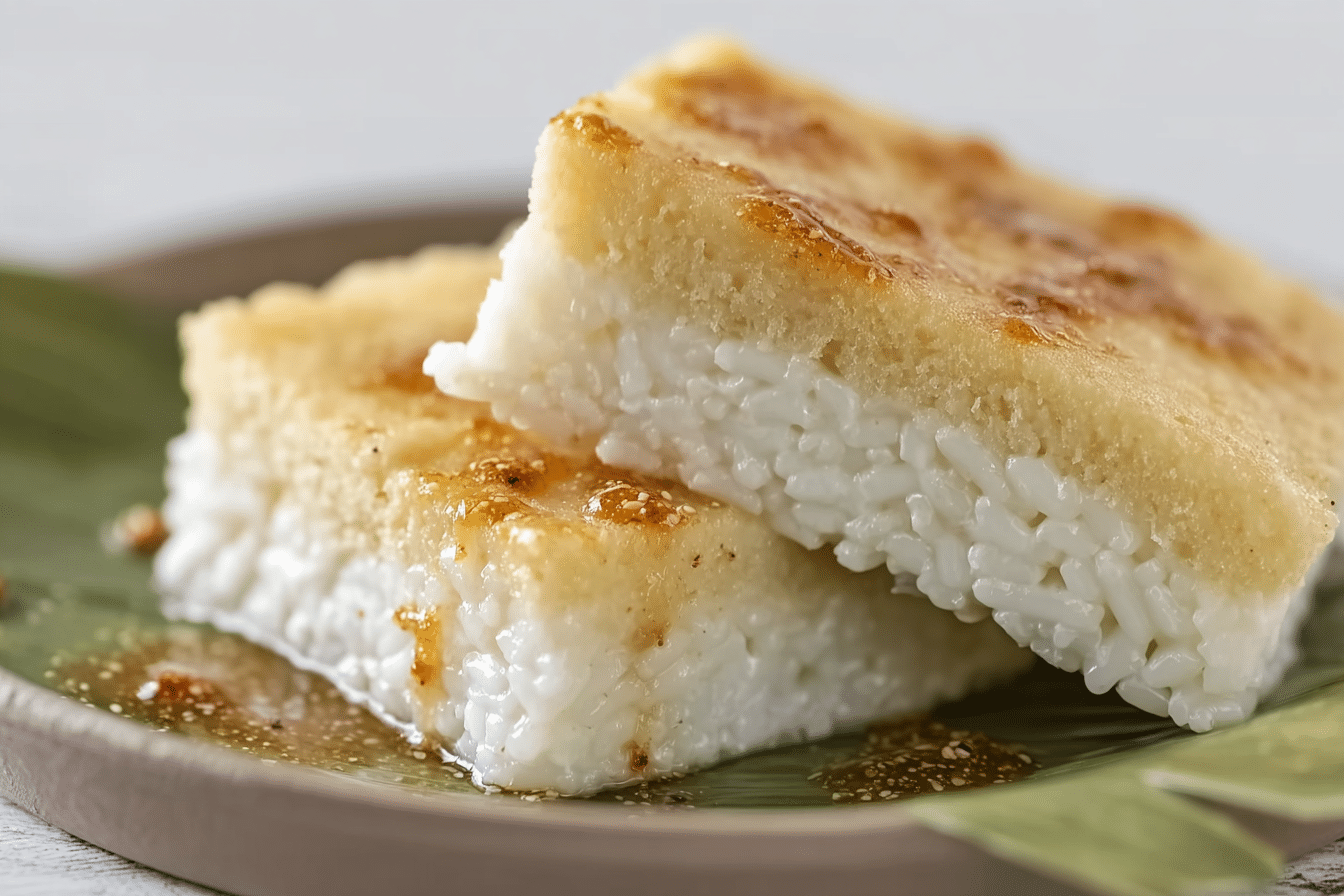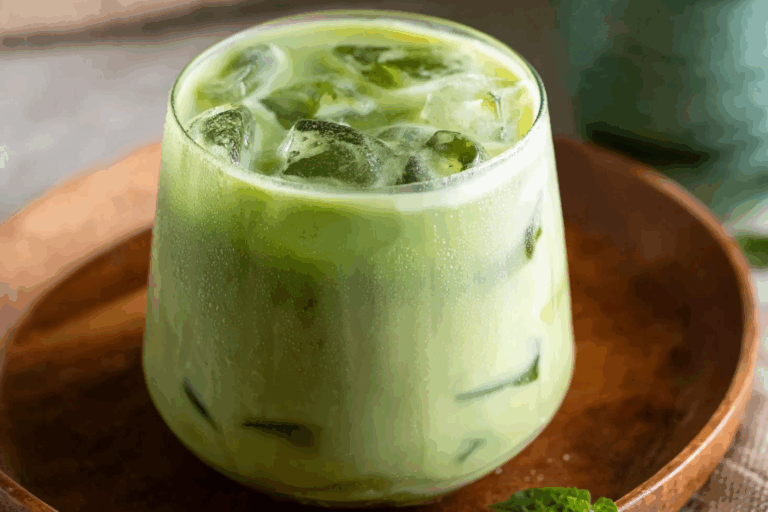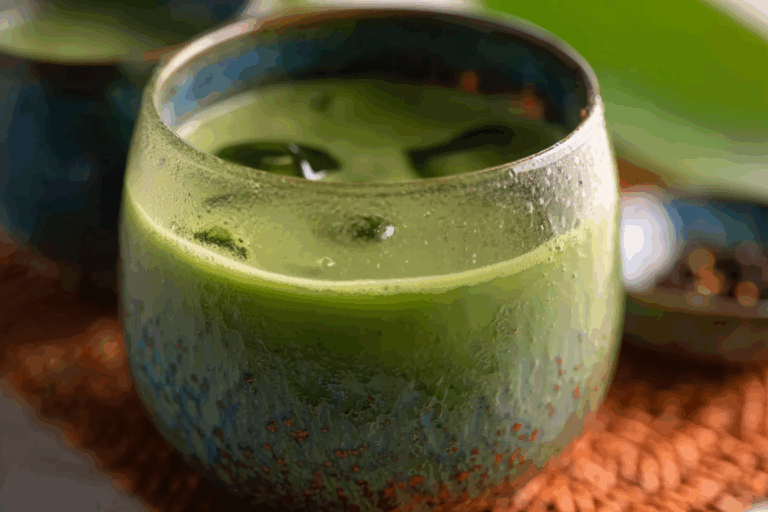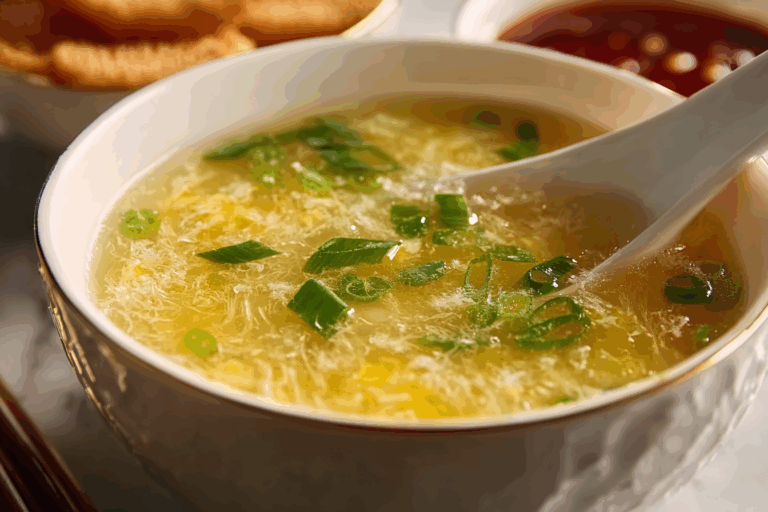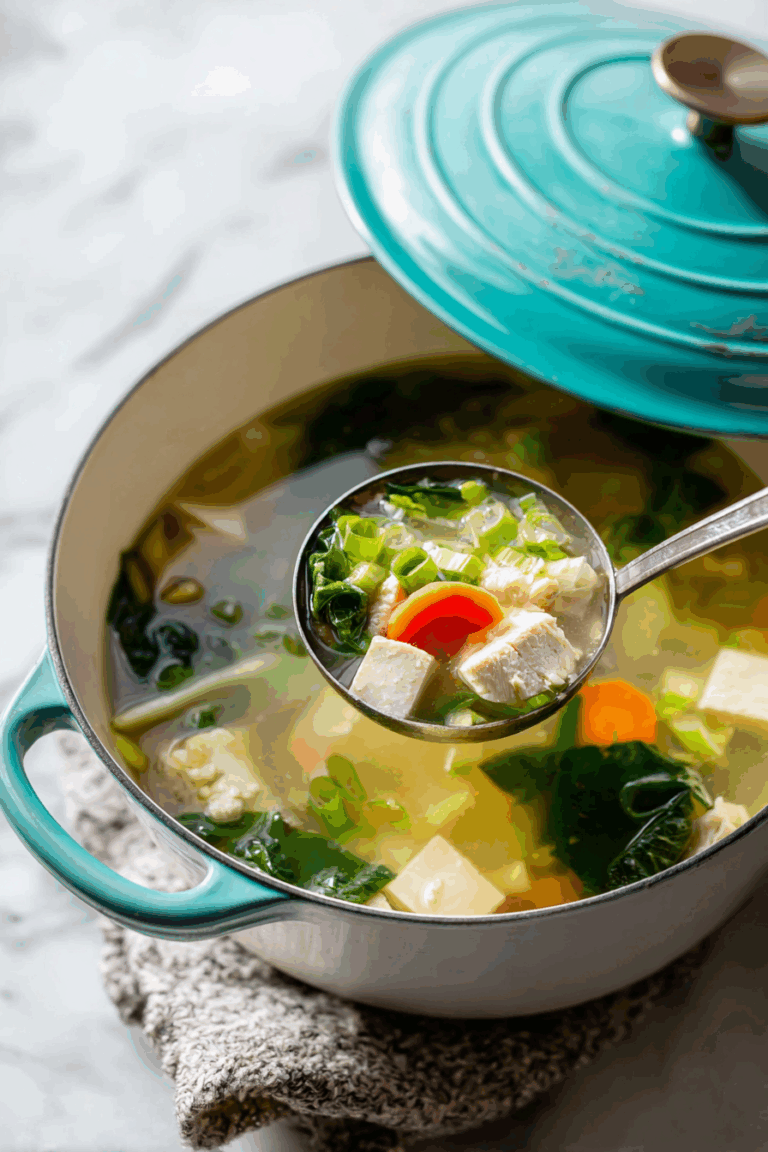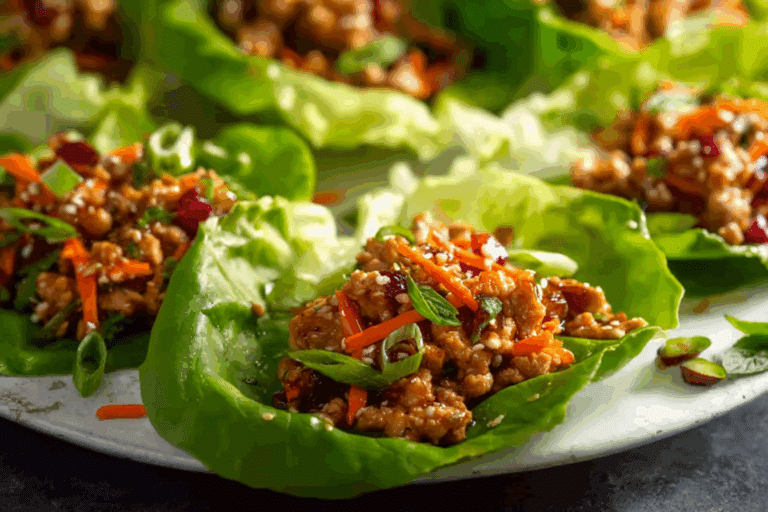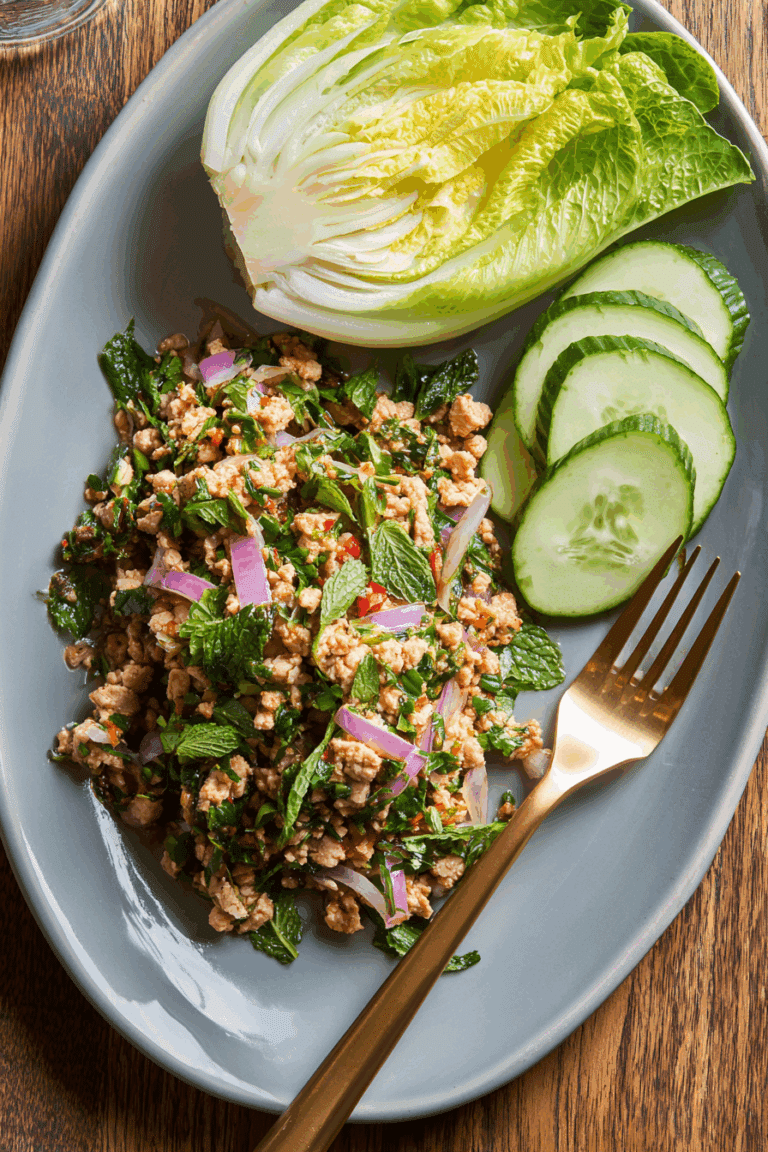Sticky Rice Layer Cake: The Ultimate Guide
Sticky Rice Layer Cake is more than just a dessertit’s a sweet, chewy, and colorful celebration of Thai culture. And here at JustThaiRecipes, it represents the heart of our culinary mission. You might’ve read our story on the About page, where Lina, our founder, talks about her passion for bringing bold Thai flavors into everyday kitchens.
The love for traditional desserts like this beautiful cake is what sparked this journey. With a rich coconut aroma, glutinous texture, and elegant layers, this cake is a testament to the joy of slow cooking and vibrant taste. Whether you’re new to Thai desserts or a seasoned enthusiast, this guide will walk you through everything from ingredients to troubleshooting so you can make an easy sticky rice layer cake that’s as authentic as it is delicious.
Table of Contents
Table of Contents
The Origins and Cultural Significance of Sticky Rice Layer Cake
A Sweet Slice of Thai Tradition
The sticky rice layer cake is more than a colorful dessert. In Thailand, it’s known as Khanom Chan, which translates to “layered dessert.” The word Chan means “layer,” and traditionally, the cake features nine layers. Why nine? Because in Thai culture, the number nine (gao) is considered lucky, symbolizing progress, success, and moving forward in life. That’s why you’ll often find this cake served at auspicious occasions such as weddings, housewarmings, and New Year celebrations.
It’s not just the number of layers that carries meaning. The bright and beautiful colors of each layer also reflect joy and celebration. In rural Thai communities, families often gather during festivals to make this cake together. It’s a bonding experience and a way to pass down culinary traditions from generation to generation.
This dessert also tells a story of regional adaptation. While most popular in Central Thailand, it has variations across the country. In the north, locals might add pandan leaves for a green hue and aromatic taste, while the south may use palm sugar for a richer flavor. Regardless of the version, the essence remains the same—a chewy, sweet, and delicately layered cake steamed to perfection.
How Sticky Rice Layer Cake Evolved
As Thai cuisine has spread globally, so has this dessert. Today, sticky rice layer cake recipes are found on food blogs, in cookbooks, and across social media platforms, gaining popularity not only for its taste but also for its aesthetic. With layers that can be customized in any color palette, this dessert doubles as a culinary art project.
Modern recipes now include global ingredients like condensed milk or flavor extracts like vanilla and rose. Some even turn it into a sticky rice cake with condensed milk, offering a sweeter, creamier experience while maintaining the chewy glutinous base. Vegan versions have also surfaced using plant-based coconut milk and natural food coloring from beetroot, matcha, and turmeric.
Despite these changes, the core remains true to its roots: a steamed cake made with glutinous rice flour, coconut milk, and sugar. Whether you make it the traditional nine-layer way or modernize it with new flavors, each bite offers a taste of Thailand’s culinary heritage.
Print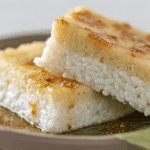
Sticky Rice Layer Cake
- Prep Time: 15 minutes
- Cook Time: 45 minutes
- Total Time: 3 hours
- Yield: 8–10 slices 1x
- Category: Dessert
- Method: Steaming
- Cuisine: Thai
- Diet: Gluten Free
Description
Sticky Rice Layer Cake is a traditional Thai dessert made with glutinous rice flour, coconut milk, and sugar. Steamed in vibrant layers, it’s chewy, sweet, and visually stunning—perfect for celebrations or as a unique treat.
Ingredients
- 1 cup glutinous rice flour
- 2/3 cup tapioca flour
- 1 (13 1/2-ounce) can plus 1/4 cup coconut milk
- Pinch salt
- 3/4 cup white sugar
- 2 teaspoons coconut flavoring
- 4 drops red food coloring, or other color(s) of your choice
- 1/4 cup shredded coconut, for decoration, optional
Instructions
- Combine glutinous rice flour and tapioca flour in a large bowl. Add salt and sugar, then stir well.
- Pour in coconut milk and coconut flavoring. Mix by hand or on low speed until smooth.
- Divide batter into two bowls. Add red food coloring to one for a pink layer, leave the other white or use other colors.
- Grease a loaf pan lightly with cooking oil.
- Set the loaf pan inside a steamer, wok, or large pot with a lid, filled with about 1 inch of water.
- Pour about 1/3 of one colored batter into the pan (1/4 to 1/2 inch thick layer).
- Bring the water to a boil, then reduce to a gentle simmer and steam the first layer for 5 minutes.
- Add the next layer (alternate color), then steam for 8 to 10 minutes or until firm.
- Repeat layering and steaming until batter is used, adding extra food coloring to the last layer for contrast.
- After final layer is steamed, let the cake cool in the pan for 10 minutes, then refrigerate until firm.
- Once cold, run a knife around the pan to loosen the cake and gently remove it.
- Slice using a sharp, non-serrated knife. Serve at room temperature, optionally topped with shredded coconut.
Notes
- Always allow each layer to fully steam before adding the next.
- Use natural food coloring alternatives like beet juice or pandan for a healthier version.
- Chilling helps firm the cake for easier slicing.
- Do not freeze the cake, as it may lose its texture.
- Use light coconut milk to reduce fat content if desired.
Nutrition
- Serving Size: 1 slice
- Calories: 150
- Sugar: 12g
- Sodium: 25mg
- Fat: 6g
- Saturated Fat: 5g
- Unsaturated Fat: 1g
- Trans Fat: 0g
- Carbohydrates: 24g
- Fiber: 1g
- Protein: 1g
- Cholesterol: 0mg
Keywords: Sticky Rice Layer Cake, Thai dessert, steamed cake, coconut milk dessert, gluten-free Thai dessert, colorful rice cake
Key Ingredients and Their Role in Sticky Rice Layer Cake
The Foundation: Glutinous Rice Flour and Tapioca Flour
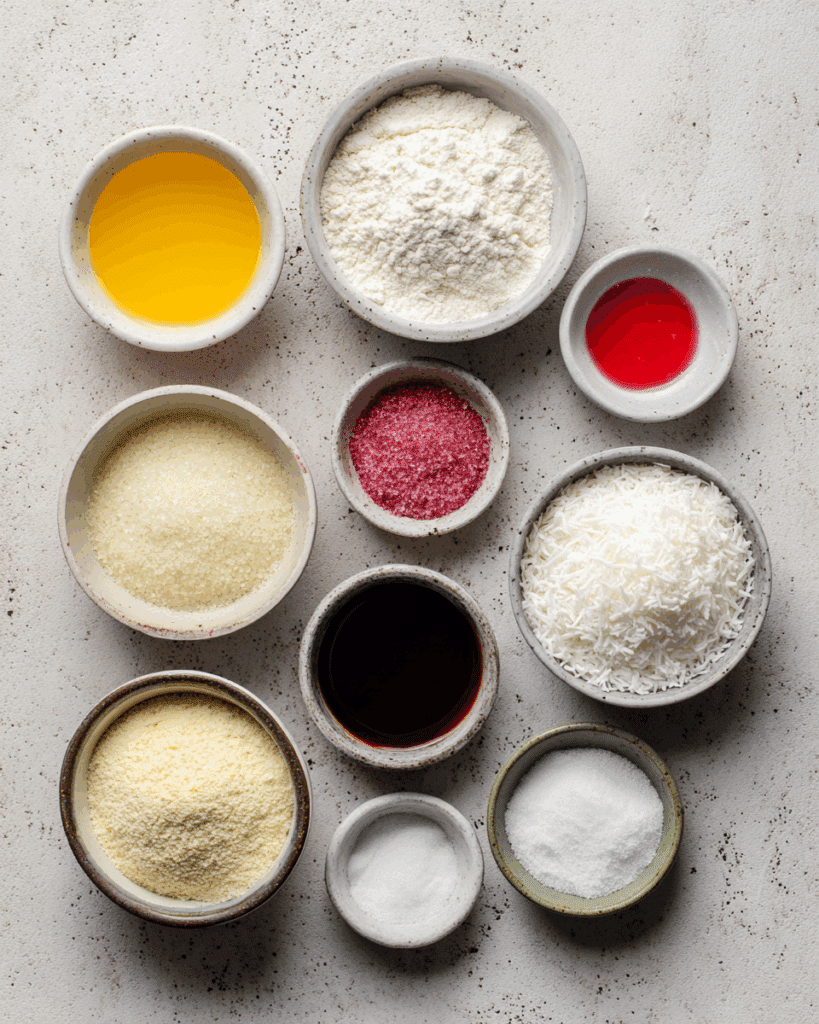
The texture of a sticky rice layer cake depends entirely on its flours. You might think any rice flour would do, but there’s a big difference. Glutinous rice flour, also known as sweet rice flour, is the star of the show. It’s what gives the cake its soft chewiness and dense texture. Without it, the cake simply wouldn’t have its signature sticky bite.
Tapioca flour, on the other hand, adds elasticity. Sourced from the cassava plant, it gives the layers their slight bounce and helps the cake hold its shape. The combination of these two flours—1 cup of glutinous rice flour and ⅔ cup of tapioca flour—is perfect for achieving that just-right firmness when steamed.
If you can’t find these ingredients locally, don’t worry. They’re widely available in Asian supermarkets and online. When buying, make sure you’re selecting “glutinous” rice flour—not just plain rice flour. That word “glutinous” doesn’t refer to gluten but to the sticky, gluey texture it creates when cooked.
Looking for another traditional Thai dessert with a twist on rice flour? Discover great ideas like Thai Rolled Ice Cream: How To Make The Ultimate Summer Dessert—it’s a cold favorite, but just as foundational in Thai cuisine.
Creaminess and Flavor: Coconut Milk and Coconut Flavoring
Coconut milk is the liquid gold that makes this dessert so luscious. Using a full can (13½ oz) plus an additional ¼ cup gives the batter its smooth richness. It also balances the sweetness of the sugar with a creamy mouthfeel. The fat in the coconut milk is essential because it helps form smooth layers when steamed. Always shake the can before using to ensure the cream and liquid haven’t separated.
To amp up the tropical taste, you can add 2 teaspoons of coconut flavoring. Some recipes also use pandan extract for a fresh, floral aroma or rose water for a more delicate finish. If you’re aiming for a more decadent version, try making a sticky rice layer cake with condensed milk. Swap out a portion of the sugar and coconut milk for condensed milk to enhance the richness.
If you love working with coconut in Thai cooking, don’t miss our Thai Coconut Soup with Shrimp: The Ultimate Comfort Bowl. The creamy profile is surprisingly similar.
Sweetness and Color: Sugar and Food Coloring
This recipe uses ¾ cup of white sugar. That might seem like a lot, but the sweetness is balanced by the rich coconut base. You can adjust this slightly depending on your preference. Some bakers prefer palm sugar for a more caramelized taste, though this changes the color and creates a more rustic-looking cake.
As for color, you’ll need just 4 drops of red food coloring (or a mix of colors if you’re feeling adventurous). Traditional cakes often use only two alternating colors—usually white and pink—but feel free to experiment. The more colors you use, the more festive and visually stunning your layers become.
In fact, for a bolder dessert experience, check out the Thai Tea Crème Brûlée Recipe That Will Blow Your Mind. It combines vibrant color and Thai ingredients in a truly unique way.
Optional Topping: Shredded Coconut
Sprinkling shredded coconut on top before serving adds a lovely texture contrast. It’s not essential to the recipe, but it does give each slice an appealing finish. Toast it lightly if you prefer a bit of crunch or leave it soft for that chewy, fresh coconut touch.
If you enjoy adding texture to your Thai dishes, don’t miss our take on crispy and soft in Thai Yellow Chicken Curry with Potatoes – The Ultimate Cozy Dish. It’s another Thai favorite where texture is just as important as flavor.
Step-by-Step Guide to Making the Perfect Sticky Rice Layer Cake
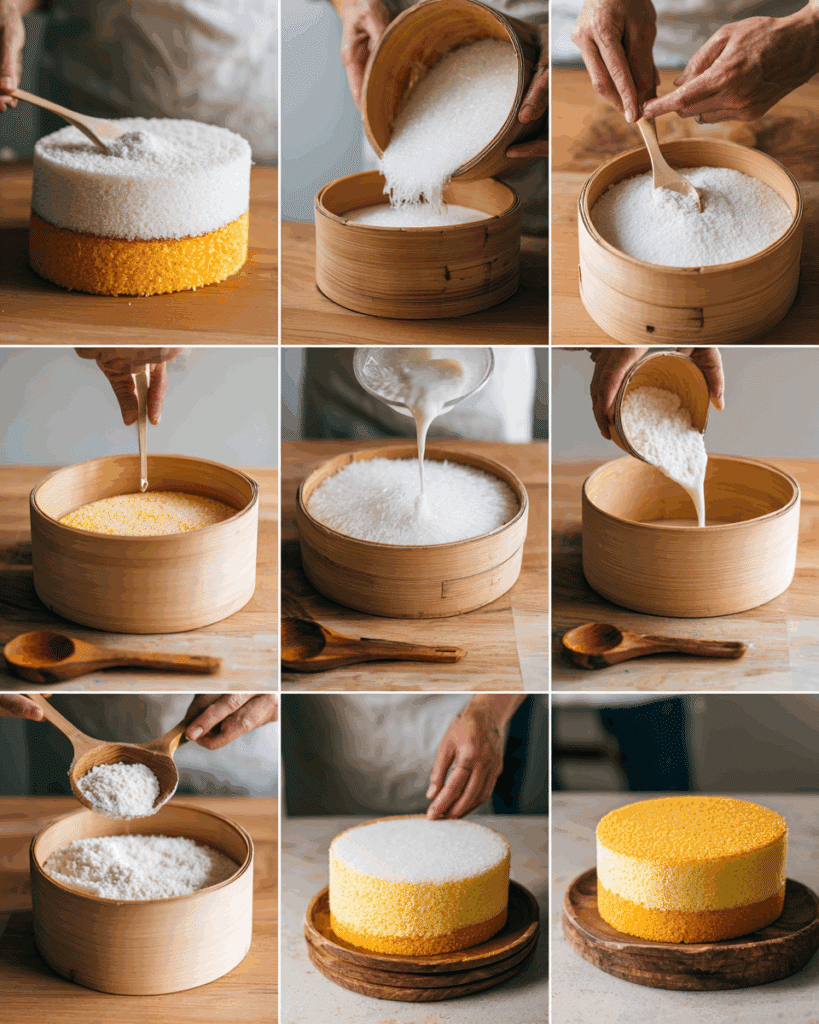
Preparing the Batter: Mixing Technique and Texture
Creating the perfect sticky rice layer cake recipe starts with mastering the batter. Begin by combining your dry ingredients—1 cup of glutinous rice flour and ⅔ cup of tapioca flour—in a large mixing bowl. Stir in a pinch of salt and your ¾ cup of white sugar. Make sure the mixture is uniform, with no visible clumps.
Next, slowly pour in the coconut milk and the coconut flavoring. Stir this mixture gently using a whisk or electric beater on low speed. Whisking by hand allows you to control the batter’s consistency better. The result should be a silky, slightly thick mixture. Once smooth, divide the batter evenly into two bowls.
To one bowl, add about 4 drops of red food coloring. Mix until you have a soft pink hue. If you’re experimenting, you can divide the batter into more than two bowls and use additional food coloring for a more vibrant, festive cake. This step is especially fun if you’re making an easy sticky rice layer cake for birthdays or holiday celebrations.
For inspiration on how professional chefs layer and color their steamed cakes, take a peek at the traditional approach shared by The Spruce Eats in this colorful Thai steamed layer cake guide. Their rainbow approach is a beautiful twist on the classic.
Choosing the Right Steaming Setup
Now let’s talk about equipment. You’ll need a loaf pan, preferably glass so you can see your layers forming. Grease the pan lightly with a neutral cooking oil. Then, place it inside a steamer. If you don’t own one, a flat-bottomed wok or large soup pot works perfectly. Just ensure the loaf pan fits comfortably inside and that you have a lid that seals tightly.
Add water to the bottom of the steamer or pot. Keep it about 1 inch deep—just enough for steaming, but not so much that it boils up into the batter. Bring the water to a gentle boil.
Pour about one-third of your first batter (pink or white) into the pan, creating a layer about ¼ to ½ inch thick. Steam this layer for 5 minutes until it’s firm to the touch. Then, pour your second color layer and steam for 8–10 minutes. Each subsequent layer takes slightly longer due to rising steam temperature.
To explore another cultural take on this style of dessert, explore the Vietnamese version called Bánh Da Lợn from Runaway Rice, available here: Steamed Layer Cake – Banh Da Lon. Their method includes mung bean paste and pandan flavors—a beautiful cross-cultural comparison.
Layering and Steaming Tips
The key to a successful sticky rice layer cake with rice flour is patience and consistency. Make sure each layer is fully cooked before adding the next. You can press gently on the surface to test firmness. If it’s still sticky or leaves a dent, let it steam a bit longer.
Be prepared to add more water to your steamer every 10–15 minutes. Hot water evaporates quickly, and dry steaming can cause burning or uneven cooking. If you want a striking top layer, add a few extra drops of food coloring to the final portion of batter. It gives the cake a nice pop of color once sliced.
TravelingChili offers a helpful alternative method for steaming and frosting in their article on sticky rice cake with coconut cream. Check it out here: Sticky Rice Cake with Coconut Cream Frosting. Their version introduces an extra level of indulgence that pairs perfectly with tropical flavors.
Cooling, Slicing, and Serving
Once the cake is done, let it cool in the pan for at least 10 minutes. This helps firm it up before transferring it to the refrigerator. Chilling the cake for a few hours or overnight makes slicing much easier and cleaner. Once it’s fully chilled, run a butter knife around the edges and gently release the cake from the pan.
To slice, use a sharp non-serrated knife and press down in one motion. Avoid using a sawing motion, which can cause the layers to tear. You can cut the cake into traditional rectangles or get creative with squares and diamonds.
Serve at room temperature and optionally top with shredded coconut for a final Thai touch. This dish is perfect for parties, offerings, or simply as a comforting snack.
Troubleshooting Common Sticky Rice Layer Cake Issues
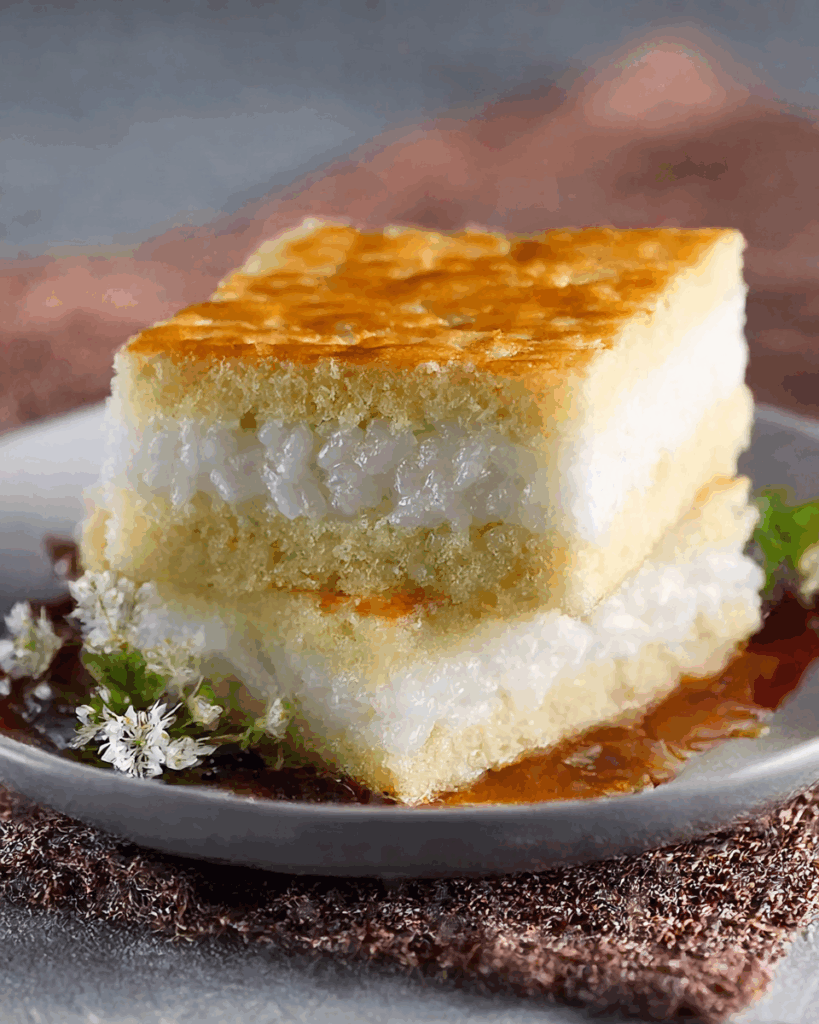
Why Are My Layers Not Sticking Together Properly?
One of the most common issues with a sticky rice layer cake is when the layers don’t bind well, causing the cake to fall apart when sliced. This typically happens when the batter isn’t steamed long enough or evenly. If one layer remains slightly undercooked, it will resist bonding with the next. Always test the firmness of each layer with a clean finger. If it feels soft or leaves an imprint, give it a few more minutes.
Another possible cause is rushing the layering process. It’s crucial to pour each new layer gently and evenly. Let the layer settle for a few seconds before placing it in the steamer. Too much vibration from a boiling pot or a lid that doesn’t fit tightly can also cause uneven steam distribution, affecting the texture and bonding.
Why Is the Cake Too Soft or Mushy?
If your finished cake feels too soft or doesn’t hold shape after cooling, your ratio of liquids to dry ingredients may be off. Be precise with your measurements. Even an extra tablespoon of coconut milk can tip the balance, making the cake overly soft.
Also, resist the urge to cut the cake too soon. Even if it feels set on top, the inner layers need cooling time to firm up. Always refrigerate for at least two hours before slicing. If you’re in a humid climate, cooling may take longer, so be patient. Chilling helps the starches settle, making the cake easier to handle.
Why Did My Cake Ripple or Bubble in the Middle?
That ripple effect in the middle of the cake is more common than you might think. It happens when steam pushes up through the batter too aggressively, usually from too much heat or boiling water splashing up into the pan. To avoid this, make sure the water is gently boiling—not at a rolling boil. Also, avoid overfilling the steamer or pot. Water should stay at least 1 inch below the pan edge.
Using a lid with a towel wrapped around it can help absorb excess moisture and reduce condensation dripping into the batter, which causes texture issues and bubbling.
Why Is My Cake Cracking or Drying Out?
A properly steamed sticky rice layer cake should be soft, moist, and slightly springy. If you’re seeing cracks or dryness, there’s likely too much steam loss or not enough liquid in your batter. Cracking can also happen if you over-steam or steam uncovered.
Always cover the steamer tightly to trap the steam inside. Avoid peeking too often as this lowers the temperature and prolongs cooking time, which may result in drier layers. Also, make sure you grease the pan lightly with oil to maintain moisture at the base.
If your environment is especially dry, consider covering the top of the loaf pan loosely with foil during the final layers. This prevents surface drying and helps maintain the glossy top finish typical of a well-steamed Thai dessert.
Can I Fix a Sticky Rice Cake That Didn’t Set Properly?
Yes, you may still be able to salvage a cake that’s too soft or undercooked. If it hasn’t yet been refrigerated, return it to the steamer and continue steaming each layer for 3 to 5 minutes more. Don’t add new layers; just reinforce the ones already there. Let the cake cool completely again before chilling.
For a cake that didn’t slice well but tastes fine, you can cut it into rustic cubes or roll it into balls for a bite-sized version. These make lovely sweet treats and still carry all the flavor and texture, even if the appearance isn’t perfect.
Variations of Sticky Rice Layer Cake for Every Taste
Making It Vegan-Friendly
The traditional sticky rice layer cake is already almost vegan, which makes it very easy to adapt. Most of the original ingredients, like glutinous rice flour, tapioca flour, coconut milk, and sugar, are naturally plant-based. To ensure your cake stays fully vegan, double-check your food coloring and coconut flavoring. Some artificial dyes and flavors contain animal-derived ingredients, so opt for brands that are clearly labeled as vegan.
You can also explore natural colorants. Beetroot juice provides a beautiful pink hue, pandan leaf extract gives a fresh green shade, and turmeric can be used for soft yellow layers. These ingredients not only color your cake naturally but also infuse subtle flavors that enhance its taste.
Experimenting with Sweetness Levels
If you’re someone who prefers a lighter dessert, you can reduce the sugar slightly. Use around two-thirds of the original amount if you’re aiming for a less sweet finish. Just be cautious not to remove too much, as sugar plays a role in binding and helps give the cake structure. It also balances the richness of the coconut milk and deepens the overall flavor.
For a richer, sweeter result, adding sweetened condensed milk is a popular option. It creates a creamy texture and boosts sweetness without the need for extra sugar. This transforms the dessert into a sticky rice layer cake with condensed milk, often preferred for special occasions where a more decadent finish is desired.
Color and Layer Variations
Although two colors—usually white and pink—are traditional, you can create multi-color versions that are just as authentic. Some bakers prefer alternating three or four colors in thinner layers, creating a vibrant rainbow-like look. Each layer can be as thin as a quarter inch or as thick as half an inch, depending on your aesthetic preference.
You can go a step further by flavoring each color differently. Try using rose essence for pink layers, pandan for green, and vanilla for white. This adds a playful dimension to your cake without complicating the process. Each bite offers a slightly different taste and aroma, keeping the experience fun and engaging.
Texture Twists: Adding Chew and Crunch
For a different mouthfeel, consider mixing in shredded coconut or soaked chia seeds to some of the layers. These ingredients add a gentle chew and change the cake’s consistency without overpowering the base. Another twist is to toast the shredded coconut before sprinkling it on top. This adds not only a nutty flavor but also a light crunch.
You can even fold in sesame seeds or crushed peanuts on the top layer before steaming. This offers a slight crispiness when the cake is served, contrasting beautifully with the soft layers beneath.
Turning It into a Fusion Dessert
Sticky rice layer cake can easily be paired with other cuisines to create a fusion dessert. Try serving it alongside tropical fruits like mango or papaya. You could also plate it with a drizzle of chocolate or caramel sauce for a bold twist. Some even serve it with a scoop of coconut or vanilla ice cream for a cold and creamy contrast.
For a Western twist, you can shape the cake using cookie cutters to form hearts, stars, or seasonal symbols. These creative shapes are perfect for holiday platters, birthday spreads, or afternoon tea treats.
Each of these variations gives the classic sticky rice cake a fresh identity while preserving its traditional core. Whether you’re keeping things classic or adding your own flair, this dessert adapts beautifully to your personal taste and creativity.
How to Store, Slice, and Serve Sticky Rice Layer Cake
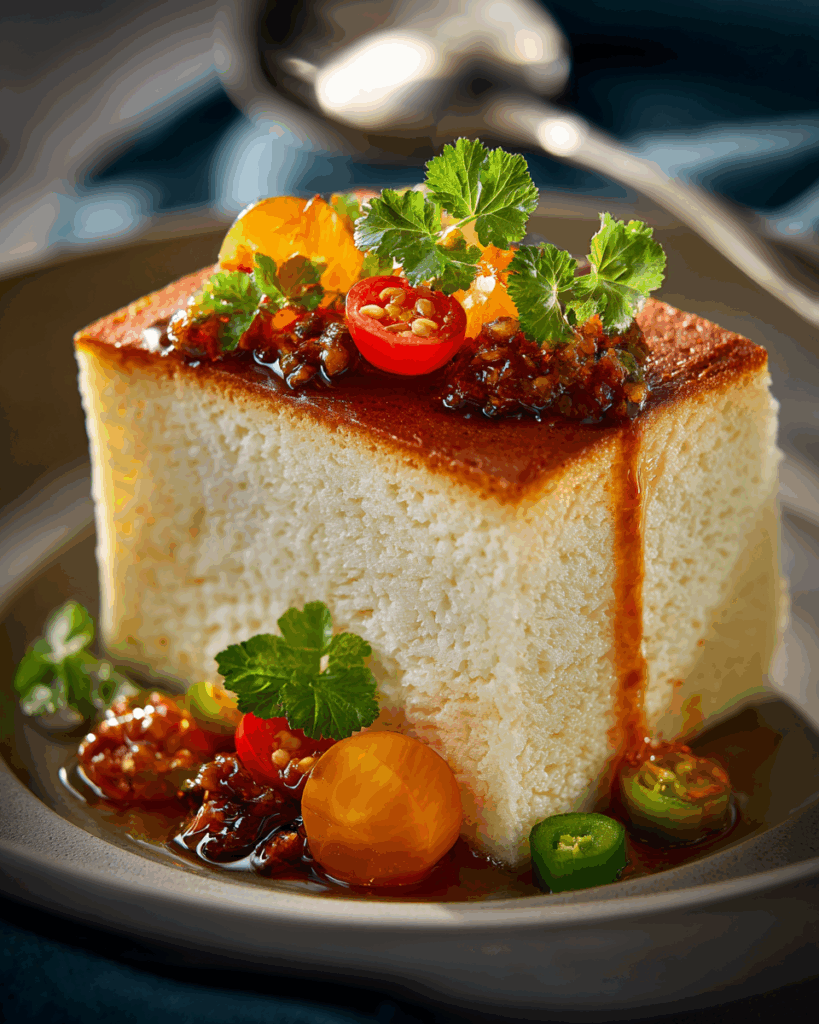
Cooling Down and Setting the Cake Properly
After your final layer is steamed and fully cooked, it’s essential to let the sticky rice layer cake rest before moving on to slicing or serving. Place the pan on a heat-safe surface and allow it to cool at room temperature for at least 10 minutes. This initial cooling stage helps the cake stabilize and allows the steam inside the layers to gradually release. It also prevents the cake from becoming overly moist or soggy at the base.
Once the surface no longer feels warm to the touch, transfer the pan to the refrigerator. Refrigerate for at least two hours, though overnight chilling is ideal for clean slicing. The cold helps firm up the cake, making the layers hold their shape better. A chilled cake is far less likely to tear or stick to your knife during slicing.
The Right Tools for Slicing Clean Layers
Using the correct knife makes a big difference. Opt for a sharp, non-serrated knife with a straight edge. Before slicing, you can dip the blade into hot water and wipe it dry. This warm blade technique helps you glide through the sticky texture more smoothly. Repeat this after every few slices for consistent clean cuts.
When you begin slicing, press straight down in one motion. Avoid sawing back and forth, as this can drag the layers and cause smearing or tearing. For the best presentation, cut the cake into small rectangles or diamonds, typically about two inches wide. These bite-sized pieces are traditional and easy to handle.
If you want a fancier touch, you can use a cookie cutter to create festive shapes. Just press the cutter into the chilled cake and gently release. This technique is perfect for special occasions or to impress guests with minimal extra effort.
Presentation Tips for Stunning Displays
Presentation adds just as much to the experience as flavor. Lay your pieces on a white or neutral-colored plate to highlight the vibrant colors of the cake layers. If using more than two colors, arrange the pieces in a pattern to showcase the full color spectrum. A garnish of fresh mint or edible flowers enhances the appearance without overpowering the taste.
You can also sprinkle a small amount of toasted shredded coconut or lightly dust the surface with powdered sugar just before serving. This adds a textural contrast and enhances the visual appeal. Remember that while this cake is served cold or at room temperature, letting it sit out for too long may cause it to soften or lose its structure.
For larger gatherings, consider layering your cake slices with thin fruit wedges such as mango or kiwi for added brightness and flavor balance. This makes each serving feel like a complete dessert rather than just a slice.
Storing Leftovers the Right Way
Sticky rice layer cake stores well if handled properly. Wrap the entire cake or individual pieces tightly in plastic wrap or place them in an airtight container. Keep them refrigerated for up to five days. Over time, the texture may become slightly firmer, but this can be softened by leaving the slices out at room temperature for 15 to 20 minutes before serving.
If you’re storing multiple layers in a single container, separate them with wax or parchment paper to avoid sticking. This is especially helpful if you’ve added toppings or garnishes that may hold moisture.
Avoid freezing this dessert. While technically possible, freezing alters the chewy texture and can lead to condensation when thawed, making the cake overly wet and causing the layers to break down.
Reimagining Leftovers Creatively
If you have leftover slices that feel slightly dry or you want to give them a new twist, consider pan-frying them lightly in a nonstick skillet with a touch of coconut oil. This method creates a crispy outer layer while keeping the inside chewy. Another option is to cut the cake into small cubes and layer them in dessert cups with coconut whipped cream and fruit, turning leftovers into a tropical parfait.
This cake’s versatility ensures that no slice ever goes to waste. Whether freshly steamed or repurposed creatively, it continues to deliver the unique texture and rich flavor that makes it a beloved favorite.
Sticky Rice Layer Cake for Special Occasions and Celebrations
The Symbolic Role in Thai Celebrations
Sticky rice layer cake isn’t just a dessert—it’s a celebratory centerpiece in many Thai households. With its delicate layers and vibrant colors, the cake often symbolizes prosperity, happiness, and the promise of upward progress. This makes it a perfect offering during ceremonies like weddings, housewarmings, birthdays, and especially the Thai New Year known as Songkran.
Traditionally, the cake is made with exactly nine layers because the number nine represents good fortune in Thai culture. Each layer added to the cake reflects growth, success, and steps forward in life. When presented to elders or used in Buddhist offerings, the cake becomes more than food—it becomes a blessing, a wish for continued advancement and well-being.
Customizing the Cake for Festive Events
One of the most delightful aspects of this dessert is its flexibility. For weddings, you might use colors that match the theme of the ceremony, such as gold and white or light pastels. For birthdays, you can go bright and bold with blue, green, and pink. Since food coloring plays a big role in the appearance of the cake, the options are almost limitless.
To make the cake feel even more festive, you can top it with edible gold leaf, decorate with sugar flowers, or add layers flavored with ingredients like rose water or lavender extract. These simple customizations make the sticky rice layer cake more personal and suited to the occasion.
It also works well for cultural exchanges and potlucks. Since it’s both gluten-free and dairy-free in its traditional form, it’s a safe and inclusive dessert to share with groups that may have dietary restrictions.
Making the Cake a Family Tradition
Sticky rice layer cake is a perfect dessert to make with family, especially during holidays or long weekends. The process of pouring and steaming each layer one at a time encourages patience, cooperation, and even storytelling. It becomes an experience, not just a recipe.
Children can help stir the batter, choose the colors, and layer the mixture under supervision. Elders in the family often share stories about how they used to make the cake in their village or with their grandparents, turning the kitchen into a space for cultural transmission.
Over time, making this dessert can become a cherished tradition, passed down through generations. Families might even compete to see who can make the neatest layers or the most creative flavor combinations. And once it’s sliced and shared, it brings everyone to the table with joy and anticipation.
Presentation as a Gift
In Thai culture, gifting food is a way of showing respect, love, and goodwill. Sticky rice layer cake, with its careful preparation and symbolic richness, makes for an ideal homemade gift. Whether you wrap slices in clear boxes tied with ribbon or arrange them in decorative trays, the presentation is as meaningful as the dessert itself.
This cake’s neat appearance and ability to hold its shape make it easy to transport, and it lasts for several days when properly stored. It’s often included in gift baskets during festivals and family reunions, along with other Thai sweets like coconut jellies and mung bean treats.
Preparing and sharing this cake brings people together. It bridges generations, enhances celebrations, and allows home cooks to express creativity and love through food. When you serve or give this cake, you’re not just sharing a dessert—you’re sharing tradition, culture, and a wish for happiness.
Nutritional Information and Health Considerations of Sticky Rice Layer Cake
What’s Inside a Slice of Sticky Rice Layer Cake?
At first glance, Sticky Rice Layer Cake may look like just a colorful dessert, but it holds more than visual appeal. A typical serving of this cake is dense and satisfying because of its high starch content. Each layer contains glutinous rice flour and tapioca flour, which contribute to its chewy texture and energy-rich profile.
The base of this dessert includes coconut milk, which adds healthy fats, specifically medium-chain triglycerides (MCTs). These fats are more easily digested than other types and can provide a quick source of energy. Coconut milk also offers small amounts of vitamins and minerals such as iron, magnesium, and potassium.
Sugar plays a central role in the cake’s taste and structure, so the dessert is sweet, although not overly so when prepared traditionally. A single square of Sticky Rice Layer Cake typically contains between 120 and 180 calories, depending on the thickness of the layer and any additional toppings used.
Is Sticky Rice Layer Cake Gluten-Free?
Yes, one of the advantages of Sticky Rice Layer Cake is that it is naturally gluten-free. The use of glutinous rice flour might confuse some people due to the word “glutinous,” but this refers to the sticky texture rather than actual gluten content. This makes the dessert suitable for people with celiac disease or gluten intolerance.
Tapioca flour is also gluten-free, and when paired with plant-based coconut milk, the entire recipe remains accessible to those avoiding wheat-based ingredients. Always check the labels of store-bought flavorings or colorings to ensure they don’t contain hidden gluten additives.
This dessert is an excellent choice for gluten-sensitive individuals looking for a satisfying, chewy treat that doesn’t feel like a compromise. Whether served at a dinner party or family celebration, Sticky Rice Layer Cake offers both taste and safety for those avoiding gluten.
Sugar Content and Sweetness Management
One of the most common concerns with desserts like Sticky Rice Layer Cake is the sugar level. The standard recipe uses three-quarters of a cup of sugar, which makes the cake moderately sweet. The sweetness is balanced by the rich and creamy flavor of coconut milk, but for those who are watching their sugar intake, the recipe can be adjusted slightly without losing its structure.
You can reduce the sugar by 10 to 15 percent without significantly changing the flavor or consistency. Alternatively, for those who want to experiment with natural sweeteners, small amounts of maple syrup or coconut sugar can be substituted. These will slightly darken the batter and may affect the color layering, but they can provide a more complex sweetness.
Still, Sticky Rice Layer Cake is intended to be an occasional indulgence rather than a daily snack. Its rich texture and energy-dense ingredients make it best enjoyed in small servings, paired with tea or fruit for a well-balanced dessert.
Dietary Modifications and Customization Options
Because the base of the Sticky Rice Layer Cake is simple and plant-based, it’s highly adaptable for various dietary needs. For a lower-fat version, you can use light coconut milk, which reduces the saturated fat content without sacrificing too much creaminess. However, note that the texture may become slightly less rich and more gelatinous.
If you’re preparing the cake for people with allergies, be cautious with toppings. Shredded coconut and any added nuts or seeds should be introduced only after confirming no sensitivities. The cake itself, when kept plain, is free from dairy, nuts, eggs, and gluten, making it suitable for most dietary plans.
Parents looking for child-friendly treats often use natural fruit-based dyes for coloring. Pureed beet, carrot, spinach, or butterfly pea flower are commonly used to tint the batter while keeping the ingredients clean and healthy.
Portion Control and Mindful Eating
Even though Sticky Rice Layer Cake is made with wholesome ingredients, portion control remains important. The chewy texture and layered format can make it tempting to overindulge. To stay mindful, slice the cake into small squares or diamonds and serve on individual plates rather than buffet-style trays.
Pairing the cake with tea or fresh fruit can help create a more rounded eating experience and promote slower consumption. When served in modest portions, this dessert provides joy and satisfaction without overwhelming your daily nutrition goals.
In summary, Sticky Rice Layer Cake is a treat that balances tradition, texture, and taste. With simple ingredient swaps or reduced sugar, it can fit into many modern dietary lifestyles while still delivering the cultural richness and celebratory spirit it’s known for.
Why Sticky Rice Layer Cake Deserves a Place in Your Recipe Repertoire
A Dessert That Blends Tradition and Creativity
Sticky Rice Layer Cake is more than just a sweet treat—it’s a celebration of heritage, patience, and artistry. From its deep cultural roots in Thai traditions to its modern-day versatility, this dessert has remained a timeless favorite for generations. What makes it truly special is how it marries the old with the new. While the ingredients and techniques stay rooted in authenticity, home cooks around the world are reinventing the cake with new colors, shapes, and even fusions.
Whether you’re preparing it to honor a holiday, share with loved ones, or simply satisfy a craving, Sticky Rice Layer Cake offers a hands-on experience that’s both rewarding and meditative. Each layer you pour, steam, and stack adds to the feeling of accomplishment once you slice into the beautifully striped final product.
And unlike many modern desserts that rely heavily on processed ingredients or complex tools, this cake remains refreshingly simple in what it requires—flour, coconut milk, sugar, and steam. Yet the result is anything but ordinary. It’s soft, chewy, fragrant, and visually stunning. With just a few pantry staples and some time, you can create a dessert that feels luxurious and meaningful.
Embracing the Joy of Layered Desserts
The layered design of the Sticky Rice Layer Cake is more than just aesthetic. It’s symbolic of the patience and intention behind each step. It’s no wonder why this dessert has become a staple in celebrations and family traditions. Each slice carries not only flavor but the effort and love that went into its creation.
Layered desserts like this encourage you to slow down, focus, and take pleasure in the process. There’s a rhythm to pouring each layer, waiting as it steams, and watching as the colors and textures build upon one another. This culinary rhythm transforms the cooking process into a quiet ritual, one that’s both grounding and inspiring.
When served, the cake never fails to spark conversation. Guests admire the clean lines, bright colors, and delicate balance of sweet and creamy flavors. And once they take a bite, the tender chew and subtle coconut richness seal the impression. It’s not just a dessert—it’s a memory in the making.
A Sweet Skill Worth Mastering
If you enjoy cooking and want to expand your dessert skills beyond the usual cakes and cookies, Sticky Rice Layer Cake is the perfect project. It introduces you to steaming as a cooking method, helps you refine your layering technique, and gives you a deeper appreciation for ingredient ratios and timing. More importantly, it teaches the value of patience and precision.
As you become more confident, you’ll find countless ways to customize and innovate. You might experiment with pandan juice for a natural green hue, blend in mashed taro or purple sweet potato, or even layer in subtle flavor infusions like jasmine or ginger. Each attempt builds on your previous experience, and soon, you’ll be creating your own signature version of this beloved dessert.
Adding Sticky Rice Layer Cake to your recipe repertoire also expands your understanding of global cuisine. It connects you to Thai culinary traditions and allows you to explore a new flavor profile that’s not too sweet, not too rich, but perfectly balanced. And with every slice shared, you’re bringing a piece of that culture to your own community.
Sharing and Celebrating Through Food
Food has always been a universal language. When you prepare and serve a dessert like Sticky Rice Layer Cake, you’re speaking volumes—about your creativity, care, and appreciation for diverse culinary experiences. It’s a dessert that invites others in, starts conversations, and creates joyful moments.
Whether you’re serving it at a cultural festival, family dinner, or just as a weekend project, this cake elevates the occasion. It encourages gathering around, slicing carefully, and savoring every layer together. That’s what makes it so much more than a dessert. It’s a symbol of togetherness, heritage, and shared delight.
In a world of fast food and shortcuts, Sticky Rice Layer Cake stands out for its quiet complexity and satisfying process. It invites you to pause, layer by layer, and rediscover the beauty of cooking with intention. It may take time, but the joy it delivers is always worth the wait.
Conclusion: Embrace the Art of Sticky Rice Layer Cake
Sticky Rice Layer Cake is more than just a dessert it’s an invitation to celebrate culture, creativity, and culinary patience. Every carefully steamed layer tells a story, not only of Thai heritage but also of your own time and intention spent in the kitchen. Whether you stick to the traditional two-color style or experiment with rainbow hues, this dessert is a masterpiece waiting to happen in your own home.
With simple pantry ingredients like glutinous rice flour, tapioca flour, and coconut milk, you can recreate an authentic Thai experience right in your kitchen. The chewy, glossy texture and the sweet, coconut-infused flavor make Sticky Rice Layer Cake a standout dessert for both everyday enjoyment and special occasions.
From family gatherings to cultural events, this cake has the power to bring people together. Its gluten-free, dairy-free base makes it inclusive and accessible, while its visual beauty and versatility give it a modern appeal. Every slice offers a perfect balance of softness, sweetness, and tradition.
And beyond the flavors, there’s a deeper joy in crafting something layer by layer. As you steam, wait, and watch the cake take shape, you’re engaging in a culinary ritual that’s both mindful and rewarding. When served, it doesn’t just feed the appetite—it feeds connection, memory, and delight.
So whether you’re preparing it for the first time or looking to refine your technique, don’t hesitate to bring Sticky Rice Layer Cake into your recipe collection. It’s a dessert that gives back more than you put in, one delicious layer at a time.
Frequently Asked Questions About Sticky Rice Layer Cake
Can Sticky Rice Layer Cake be frozen for later use?
Freezing Sticky Rice Layer Cake is not recommended. Although it is possible to freeze it in an airtight container, the cake often loses its soft, chewy texture when thawed. The condensation created during the freezing and thawing process can make the layers mushy or separate unevenly. For the best results, refrigerate leftovers and consume within five days. If you must prepare it in advance, it’s better to keep it chilled and well wrapped in plastic wrap to maintain its structure and moisture.
How do I prevent the layers of Sticky Rice Layer Cake from separating?
Layer separation in Sticky Rice Layer Cake usually happens when the layers are not fully cooked or when the batter is poured too quickly. Always ensure each layer is steamed until firm before adding the next one. Press gently with a spoon or fingertip to test if the layer has set before proceeding. Also, pour each new layer slowly and evenly to prevent air pockets or shifts in texture. Keeping your steamer at a steady, gentle boil helps maintain even cooking throughout the cake.
Can I make Sticky Rice Layer Cake without food coloring?
Yes, you can absolutely make Sticky Rice Layer Cake without artificial food coloring. Many home cooks prefer using natural alternatives to achieve the same visual appeal. Beet juice gives a beautiful pink or red tone, butterfly pea flower creates a vibrant blue, pandan leaf extract turns the batter green, and turmeric provides a golden yellow. These options not only add color but also offer subtle flavors, making the cake both healthier and more aromatic. The layered effect can still be achieved even with just white and one natural-colored batter.
What is the difference between Sticky Rice Layer Cake and regular sticky rice cake?
Sticky Rice Layer Cake is a steamed dessert made with glutinous rice flour and tapioca flour, layered with colorful batters and flavored with coconut milk. Each layer is steamed individually, giving it a visually striking appearance and a chewy texture. In contrast, regular sticky rice cake usually refers to pressed or baked sticky rice formed into a solid block, often without layers, and typically not as soft or gelatinous. The layer cake also incorporates coconut flavoring and food coloring, which adds both taste and beauty.

